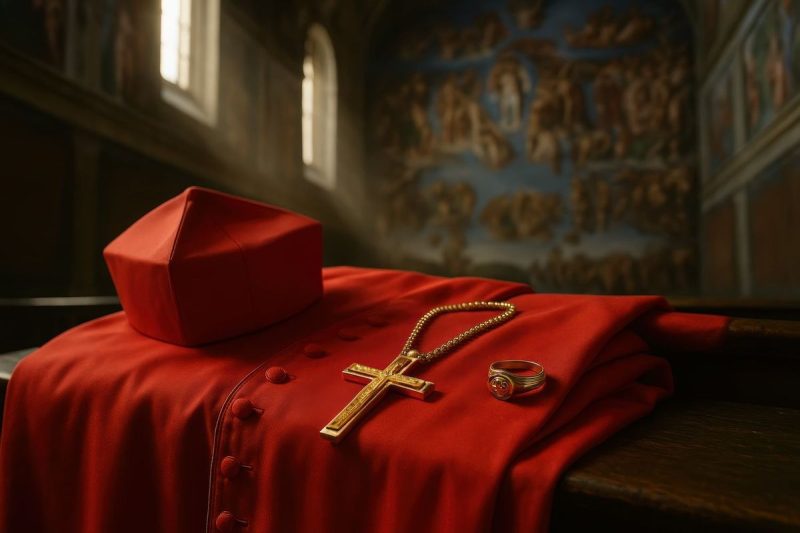
Heaven’s Earthly Treasures: Behind the Metallurgy of the Papal Symbols
As white smoke billowed from the Sistine Chapel’s chimney and the bells of St. Peter’s Basilica rang out, Robert Francis Prevost, now known as Pope Leo XIV, was casting history in gold.
The newly elected pontiff is not only the first American pope, but also the latest successor in a long line of men robed in ancient symbols and tradition — as well as precious metals.
The Vatican, for all its spiritual power and theological doctrine, is also quite literally a treasury.
From the moment a pope is elected, he is adorned with regalia that is steeped in centuries of meaning, and often crafted from some of the world’s most valuable resources.
This article explores the material makeup of the modern papacy — what it’s made of, and what it means.
The Fisherman’s Ring
At the center of every pontificate is a single golden symbol: the Fisherman’s Ring.
A custom-made signet bearing the image of St. Peter fishing — a nod to the Pope’s spiritual ancestry — the aptly named Fisherman’s Ring is a badge of papal authority. Historically, it also functioned as a seal for papal documents, though its use for that purpose was discontinued in 1842.
Gold is the traditional material, but recent pontificates have brought slight variations. Pope Benedict XVI’s ring was solid gold; Pope Francis chose gold-plated silver — a subtle nod to austerity.
The composition of Pope Leo XIV’s ring has not yet been confirmed.
Whatever its exact alloy, the symbolism remains rich. The ring is destroyed upon a pope’s death or resignation — shattered with a ceremonial hammer to prevent forgery, a powerful image of the transience of power.
The tiara’s glittering past
While Pope Leo XIV, like his recent predecessors, is unlikely to don the papal tiara — a triple-crowned headpiece entrenched in medieval grandeur — it remains one of the most opulent artifacts in Vatican history.
Traditionally crafted from silver and often adorned with diamonds, emeralds, sapphires and rubies, the tiara’s structure symbolized the pope’s threefold authority: to teach, to govern and to sanctify.
One of the most extravagant examples belonged to Pope Paul II in the 1460s; he wore a tiara encrusted with gems worth over 200,000 florins — more than US$22 million in today’s dollars. Another tiara, worn by Pope Julius II in 1503, was valued at 200,000 ducats (each ducat containing 3.5 grams of pure gold). These tiaras, now museum pieces, remain potent reminders of the Church’s historical wealth and the metals that shaped its regalia.
The modern papacy, however, has moved away from such ostentation.
Pope Paul VI was the last to wear the tiara. In 1963, just months after his coronation, he donated his own gold- and jewel-encrusted tiara to benefit the poor — a decision echoed by his successors.
The pectoral cross
Another item of note in the papal wardrobe is the pectoral cross, typically suspended from a gold or silver cord and worn over the chest. This cross often contains a relic and represents the pope’s role as shepherd of the Catholic Church, as well as a constant reminder of his burden: to bear the sins of humanity as Christ did.
Recent popes have had pectoral crosses made of solid silver or gold, often customized with inscriptions or sacred imagery. Pope Francis, for example, wore a simple silver pectoral cross featuring the image of the Good Shepherd.
The gold-embroidered red stole
Worn across the shoulders, the papal stole is not metallic, but is trimmed with elaborate gold embroidery — often hand-stitched using fine gold thread, sometimes even containing 24 karat accents.
The red stole signifies the pope’s priestly consecration and his spiritual role as a “good shepherd,” bearing the yoke of Christ. The golden accents of the stole reflect centuries of textile and metalcraft traditions.
Keys to the kingdom
Perhaps the most iconic symbol of the papacy is the crossed keys — one gold, one silver — typically shown bound by a red cord. These appear on everything from the Vatican’s flag to the papal seal and the mosaics embedded in the marble floors of St. Peter’s Basilica. The gold key represents the spiritual authority of heaven; the silver key, the temporal authority of the church on Earth. The downward-facing grips symbolize that both are wielded by the pope himself.
The materials — silver and gold — aren’t incidental; they signal divine access and earthly power alike.
The miter
Though no longer crowned with tiaras or enthroned on palanquins, modern popes still wear the miter, a ceremonial headdress. Today’s miters are typically made of silk, but many are embroidered with gold or silver threads, and some include small gemstone inlays.
Each miter is a handcrafted object, often given as a gift by a nation, religious order or diocese.
A papacy of substance and symbols
As the chants of, ‘Viva il papa!’ echo across St. Peter’s Square, and as Pope Leo XIV blesses the faithful, he does so not just with words — but with a legacy etched in precious metals.
In the end, it’s a reminder that even in matters of the soul, the Earth’s treasures still shine.
Securities Disclosure: I, Giann Liguid, hold no direct investment interest in any company mentioned in this article.
